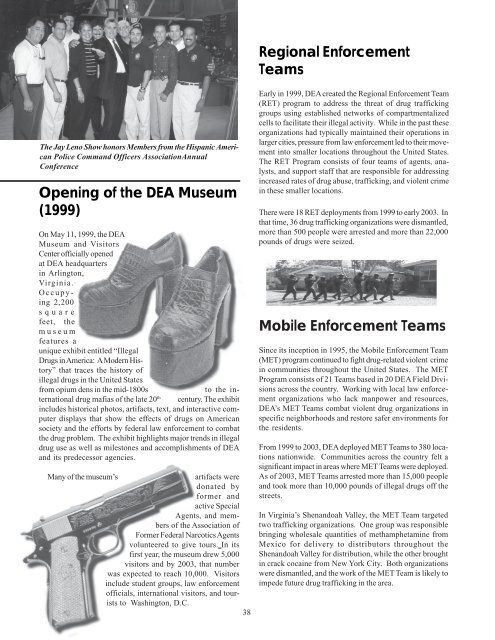Download This File - The Free Information Society
Download This File - The Free Information Society
Download This File - The Free Information Society
You also want an ePaper? Increase the reach of your titles
YUMPU automatically turns print PDFs into web optimized ePapers that Google loves.
<strong>The</strong> Jay Leno Show honors Members from the Hispanic American<br />
Police Command Officers AssociationAnnual<br />
Conference<br />
Opening of the DEA Museum<br />
(1999)<br />
On May 11, 1999, the DEA<br />
Museum and Visitors<br />
Center officially opened<br />
at DEA headquarters<br />
in Arlington,<br />
Vi rginia.<br />
Occupying<br />
2,200<br />
square<br />
feet, the<br />
museum<br />
features a<br />
unique exhibit entitled “Illegal<br />
Drugs in America: A Modern History”<br />
that traces the history of<br />
illegal drugs in the United States<br />
from opium dens in the mid-1800s to the international<br />
drug mafias of the late 20 th century. <strong>The</strong> exhibit<br />
includes historical photos, artifacts, text, and interactive computer<br />
displays that show the effects of drugs on American<br />
society and the efforts by federal law enforcement to combat<br />
the drug problem. <strong>The</strong> exhibit highlights major trends in illegal<br />
drug use as well as milestones and accomplishments of DEA<br />
and its predecessor agencies.<br />
Many of the museum’s artifacts were<br />
donated by<br />
former and<br />
active Special<br />
Agents, and members<br />
of the Association of<br />
Former Federal Narcotics Agents<br />
volunteered to give tours. In its<br />
first year, the museum drew 5,000<br />
visitors and by 2003, that number<br />
was expected to reach 10,000. Visitors<br />
include student groups, law enforcement<br />
officials, international visitors, and tourists<br />
to Washington, D.C.<br />
38<br />
Regional Enforcement<br />
Teams<br />
Early in 1999, DEA created the Regional Enforcement Team<br />
(RET) program to address the threat of drug trafficking<br />
groups using established networks of compartmentalized<br />
cells to facilitate their illegal activity. While in the past these<br />
organizations had typically maintained their operations in<br />
larger cities, pressure from law enforcement led to their movement<br />
into smaller locations throughout the United States.<br />
<strong>The</strong> RET Program consists of four teams of agents, analysts,<br />
and support staff that are responsible for addressing<br />
increased rates of drug abuse, trafficking, and violent crime<br />
in these smaller locations.<br />
<strong>The</strong>re were 18 RET deployments from 1999 to early 2003. In<br />
that time, 36 drug trafficking organizations were dismantled,<br />
more than 500 people were arrested and more than 22,000<br />
pounds of drugs were seized.<br />
Mobile Enforcement Teams<br />
Since its inception in 1995, the Mobile Enforcement Team<br />
(MET) program continued to fight drug-related violent crime<br />
in communities throughout the United States. <strong>The</strong> MET<br />
Program consists of 21 Teams based in 20 DEA Field Divisions<br />
across the country. Working with local law enforcement<br />
organizations who lack manpower and resources,<br />
DEA’s MET Teams combat violent drug organizations in<br />
specific neighborhoods and restore safer environments for<br />
the residents.<br />
From 1999 to 2003, DEA deployed MET Teams to 380 locations<br />
nationwide. Communities across the country felt a<br />
significant impact in areas where MET Teams were deployed.<br />
As of 2003, MET Teams arrested more than 15,000 people<br />
and took more than 10,000 pounds of illegal drugs off the<br />
streets.<br />
In Virginia’s Shenandoah Valley, the MET Team targeted<br />
two trafficking organizations. One group was responsible<br />
bringing wholesale quantities of methamphetamine from<br />
Mexico for delivery to distributors throughout the<br />
Shenandoah Valley for distribution, while the other brought<br />
in crack cocaine from New York City. Both organizations<br />
were dismantled, and the work of the MET Team is likely to<br />
impede future drug trafficking in the area.

















